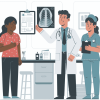
Fostering A Culture Of Continuous Improvement Through Patient Feedback
In today’s healthcare landscape, the ability to adapt and improve continuously is critical to delivering exceptional patient care. By integrating patient feedback into daily practices, healthcare organizations can create a culture that Fostering Continuous Improvement, ensuring that patient care evolves to meet the highest standards.
Building A Patient Feedback System
Building a Patient Feedback System involves creating methods to collect and use patient input to improve healthcare services. It includes gathering feedback through various channels, ensuring confidentiality, and analyzing the data to enhance patient care and satisfaction.
Developing An Effective Patient Feedback System
An effective patient feedback system is the foundation of continuous improvement in healthcare. This system enables healthcare providers to gather, analyze, and act on feedback to enhance service delivery. Here’s how to create a robust patient feedback system:
- Multiple Feedback Channels: Offer patients various ways to provide feedback, including online surveys, suggestion boxes, patient interviews, and mobile apps. By providing multiple channels, you ensure that all patients can share their experiences in a way that suits them best.
- Anonymity and Confidentiality: Ensure that feedback is collected anonymously and kept confidential. This encourages more honest and open communication from patients, which leads to more actionable insights.
- Real-Time Feedback Collection: Implement systems that allow for real-time feedback collection. Capturing feedback during or immediately after a patient’s visit ensures that the information is accurate and relevant.
- Data Analysis and Reporting: Utilize data analysis tools to identify trends and areas for improvement. Regularly review feedback reports to prioritize and address issues, track the impact of changes, and continue refining the feedback process.
Implementing Patient Experience Feedback
Patient experience feedback focuses on the overall journey a patient undergoes within a healthcare facility. Implementing this type of feedback involves several strategic steps:
- Targeted Surveys: Design surveys that focus on key aspects of the patient experience, such as staff interaction, waiting times, and the facility’s environment. These targeted surveys help gather detailed insights that are crucial for improvement.
- Focus Groups: Conduct focus groups with patients to explore their experiences more deeply. This qualitative approach can uncover underlying issues that may not be evident through surveys alone.
- Follow-Up Mechanisms: After collecting feedback, it is important to follow up with patients to inform them about the changes being implemented based on their input. This not only builds trust but also encourages ongoing patient engagement.
Creating a Culture of Continuous Improvement
A culture of continuous improvement is an organizational mindset where every member is dedicated to consistently enhancing processes, services, and outcomes. In healthcare, this means continuously seeking ways to improve patient care based on the feedback received.
Steps To Foster Continuous Improvement Through Patient Feedback
- Leadership Commitment: Continuous improvement starts with leadership. Leaders must be fully committed to creating a culture that values patient feedback and drives improvements based on that feedback.
- Empowering Staff: Staff empowerment is key to continuous improvement. Provide healthcare workers with the tools, training, and authority to act on patient feedback. When staff feels empowered, they are more motivated to engage in initiatives that enhance patient care.
- Regular Training and Development: Regular training sessions focused on the importance of patient feedback and how to use it effectively help align the team with continuous improvement goals. This ensures everyone is committed to providing the best care possible.
- Transparency in Communication: Share patient feedback and the resulting improvement initiatives with all team members. Transparency fosters a collaborative environment where everyone is working towards common goals.
- Celebrate Successes: Recognize and celebrate the improvements made based on patient feedback. Celebrating these successes reinforces the importance of feedback and encourages further efforts toward continuous improvement.
Role Of Technology In Continuous Improvement
Technology plays a crucial role in enhancing patient feedback systems and supporting continuous improvement. Digital platforms can streamline feedback collection and analysis, enabling quicker identification of trends and faster implementation of changes. Moreover, technology can help monitor the effectiveness of improvements over time, providing a clear view of progress.
Benefits Of A Strong Feedback Culture
A strong feedback culture in healthcare boosts patient satisfaction, improves care quality, and enhances the facility’s reputation by effectively addressing patient concerns and continuously refining services.
Enhanced Patient Satisfaction
When healthcare providers actively seek and act on patient feedback, it leads to higher levels of patient satisfaction. Satisfied patients are more likely to return for future care and recommend the facility to others.
Improved Patient Outcomes
Patient feedback-driven improvements lead to better care practices, ultimately resulting in improved patient outcomes. Addressing patient concerns and making necessary adjustments ensures that patients receive the best possible care.
Strengthened Reputation
A healthcare organization known for its strong feedback culture will likely have a better reputation in the community. This not only helps attract new patients but also strengthens relationships with existing ones.
Conclusion
Creating a culture of continuous improvement through patient feedback is essential for healthcare organizations aiming to deliver exceptional, patient-centered care. By actively listening to patients and valuing their experiences, healthcare teams gain valuable insights that can drive meaningful changes across services and processes. This approach not only enhances patient satisfaction but also fosters a collaborative environment where both patients and healthcare providers feel invested in the outcomes. When feedback is systematically collected, analyzed, and implemented, it cultivates a cycle of improvement that strengthens trust, boosts staff morale, and ultimately leads to safer, more effective healthcare experiences.
Frequently Asked Questions (FAQs)
What Is Patient Feedback In Healthcare?
Patient feedback in healthcare refers to the information patients provide about their experiences with healthcare services, which is used to improve service quality.
How Can Patient Feedback Improve Healthcare Services?
Patient feedback helps identify areas that need improvement, allowing healthcare providers to make informed decisions that enhance the quality of care and patient satisfaction.
What Is The Role Of Patient Experience Feedback?
Patient experience feedback focuses on the patient’s overall journey within a healthcare facility, providing insights that help improve service delivery and patient satisfaction.
How Can Technology Support Patient Feedback Systems?
Technology can automate feedback collection and analysis, making it easier to identify trends, implement changes quickly, and track progress over time.
Why Is Continuous Improvement Important In Healthcare?
Continuous improvement ensures that healthcare providers are consistently enhancing their services based on patient feedback, leading to better patient outcomes and satisfaction.
Creating a culture of continuous improvement through patient feedback is essential for providing high-quality healthcare services. By developing an effective patient feedback system, empowering staff, and leveraging technology, healthcare organizations can ensure that they are meeting the needs and expectations of their patients. This not only enhances patient satisfaction and outcomes but also strengthens the organization’s reputation as a leader in the industry.
Enhance Patient Care and NABH Compliance with LazyMonkey
LazyMonkey is your all-in-one solution for improving patient care, retaining more patients, and meeting NABH standards. Our powerful QR-based feedback tool enables you to capture real-time insights from patient feedback, discharge surveys, staff and doctor evaluations, and clinical research, while also streamlining inter-departmental communication.
Transform your healthcare facility today - reach out to us at hello@lazymonkey.in, or request a demo here!
Elevate Your Restaurant Experience with LazyMonkey
LazyMonkey’s QR-based feedback system helps you gather real-time insights from customers, track satisfaction levels, and enhance the dining experience. Get instant feedback on your menu, service, and ambience, and make data-driven improvements to boost repeat customers and reviews.
Improve your restaurant today – reach out to us at hello@lazymonkey.in, or request a demo here!
Empower Student Engagement and Campus Improvement with LazyMonkey
LazyMonkey offers a seamless way to gather student feedback, track satisfaction, and enhance campus life. From course evaluations to dorm feedback, our QR-based solution makes it easy to capture valuable insights and improve student retention.
Upgrade your university experience – contact us at hello@lazymonkey.in, or request a demo here!
Streamline Feedback and Drive Performance Across Your Enterprise/Franchise with LazyMonkey
Whether you manage one or multiple locations, LazyMonkey’s QR-based feedback system helps you gather real-time employee and customer feedback. Improve operational efficiency, track satisfaction, and make data-driven decisions to enhance brand consistency and growth.
Transform your franchise today – reach out to us at hello@lazymonkey.in, or request a demo here!
Enhance Customer Satisfaction and Service Standards in Banking with LazyMonkey
LazyMonkey empowers banks to capture real-time feedback from clients across branches. Improve customer experience, assess service quality, and ensure regulatory compliance with our QR-based solution, helping you retain clients and meet banking standards.
Elevate your bank’s customer care – contact us at hello@lazymonkey.in, or request a demo here!
Boost Customer Engagement and Mall Satisfaction with LazyMonkey
LazyMonkey’s QR-based feedback tool enables you to collect feedback from shoppers, track satisfaction, and enhance the mall experience. Gather insights on store services, cleanliness, and entertainment to create an unmatched customer journey.













